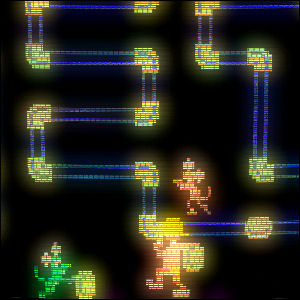 Nichibutsu releases the arcade video game Frisky Tom.
Nichibutsu releases the arcade video game Frisky Tom. ![]()

 Nichibutsu releases the arcade video game Frisky Tom.
Nichibutsu releases the arcade video game Frisky Tom. ![]()
 Exidy’s colorful coin-op video game Mouse Trap arrives in arcades, challenging players to not only keep up with the action on screen, but to tap the right color-coded door button on the control panel at the right time, allowing the mouse to escape from hungry cats. In a very short time, Mouse Trap is deemed worthy of song on Buckner & Garcia’s upcoming album Pac-Man Fever.
Exidy’s colorful coin-op video game Mouse Trap arrives in arcades, challenging players to not only keep up with the action on screen, but to tap the right color-coded door button on the control panel at the right time, allowing the mouse to escape from hungry cats. In a very short time, Mouse Trap is deemed worthy of song on Buckner & Garcia’s upcoming album Pac-Man Fever. ![]()
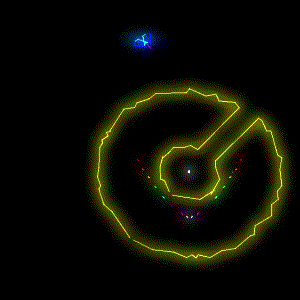 Sega/Gremlin releases the vector graphics arcade game Eliminator, in which one or two players team up (or go against each other) while trying to fire a shot down a narrow opening in a large, round, mobile space station with dangerous armament which is definitely not the Death Star. The two-player version is available as an upgright cabinet; a four-player cocktail table version is also made available.
Sega/Gremlin releases the vector graphics arcade game Eliminator, in which one or two players team up (or go against each other) while trying to fire a shot down a narrow opening in a large, round, mobile space station with dangerous armament which is definitely not the Death Star. The two-player version is available as an upgright cabinet; a four-player cocktail table version is also made available. ![]()
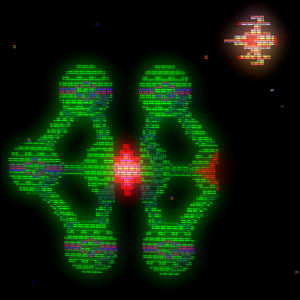 Midway releases the arcade video game Bosconian, licensed from Namco, the Japanese developers behind Pac-Man and Galaga.
Midway releases the arcade video game Bosconian, licensed from Namco, the Japanese developers behind Pac-Man and Galaga. ![]()
 Arcade game maker Universal presents its entry in the industry-wide rush to get “a game like Pac-Man” into locations everywhere, the maze chase Ladybug. This is the first game from Universal to utilize the unique “spell EXTRA” method of awarding players extra “lives”, which practically becomes a Universal trademark in later games.
Arcade game maker Universal presents its entry in the industry-wide rush to get “a game like Pac-Man” into locations everywhere, the maze chase Ladybug. This is the first game from Universal to utilize the unique “spell EXTRA” method of awarding players extra “lives”, which practically becomes a Universal trademark in later games. ![]()
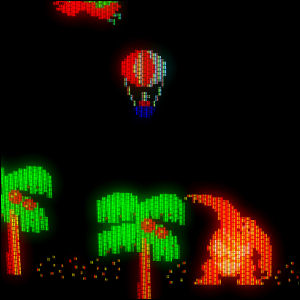 Better known for making jukeboxes and speakers, Rock-Ola continues trying to make inroads into the video game industry by releasing Fantasy in the United States. The arcade game, originated in Japan by SNK, is one of the very first coin-op games to allow players to insert additional coins to continue from the location of their previous game’s end within a set amount of time. With several screens requiring players to develop completely different strategies on the fly, Fantasy doesn’t gain much of a following; many arcade operators gut and convert their Fantasy machines into other games. (This is your webmaster’s all-time favorite arcade game.)
Better known for making jukeboxes and speakers, Rock-Ola continues trying to make inroads into the video game industry by releasing Fantasy in the United States. The arcade game, originated in Japan by SNK, is one of the very first coin-op games to allow players to insert additional coins to continue from the location of their previous game’s end within a set amount of time. With several screens requiring players to develop completely different strategies on the fly, Fantasy doesn’t gain much of a following; many arcade operators gut and convert their Fantasy machines into other games. (This is your webmaster’s all-time favorite arcade game.) ![]()
 Midway releases the arcade video game Kick, a whimsical game which is later updated to include a “guest starring” appearance by Pac-Man (to which Midway also holds the North American license).
Midway releases the arcade video game Kick, a whimsical game which is later updated to include a “guest starring” appearance by Pac-Man (to which Midway also holds the North American license). ![]()
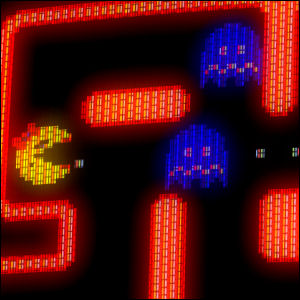 Midway delivers the long-anticipated sequel to Pac-Man to eager arcade operators. Ms. Pac-Man – a game which originated not from Pac-Man’s creators in Japan, but from an American “enhancement kit” maker called General Computer Corporation – arrives in arcades and immediately starts to break earnings records, eventually becoming the top-earning coin-op video game in American history.
Midway delivers the long-anticipated sequel to Pac-Man to eager arcade operators. Ms. Pac-Man – a game which originated not from Pac-Man’s creators in Japan, but from an American “enhancement kit” maker called General Computer Corporation – arrives in arcades and immediately starts to break earnings records, eventually becoming the top-earning coin-op video game in American history. ![]()
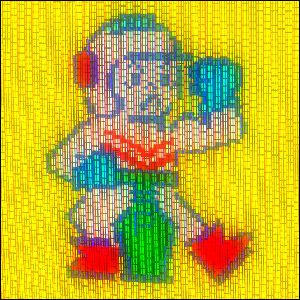 Atari releases the Namco-developed arcade video game Dig Dug in the United States. The game’s release is accompanied by an elaborate theatrical trailer, a rarity for any video game, then or now.
Atari releases the Namco-developed arcade video game Dig Dug in the United States. The game’s release is accompanied by an elaborate theatrical trailer, a rarity for any video game, then or now. ![]()
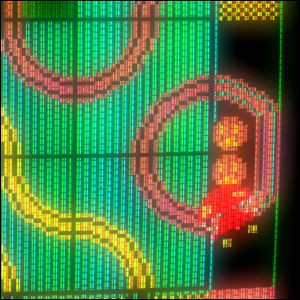 Konami introduces the arcade game Loco Motion in the United States, one of its earliest self-released coin-ops (most titles had previously been licensed through Stern).
Konami introduces the arcade game Loco Motion in the United States, one of its earliest self-released coin-ops (most titles had previously been licensed through Stern). ![]()
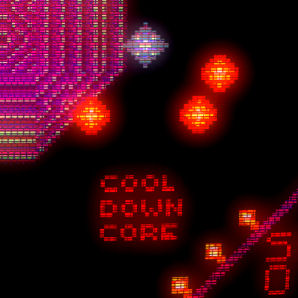 Gottlieb introduces the arcade game Reactor in the United States, a unique trackball-driven game with thumping synthesized hard rock musical accompaniment.
Gottlieb introduces the arcade game Reactor in the United States, a unique trackball-driven game with thumping synthesized hard rock musical accompaniment. ![]()
 The Stateside arm of Japanese video game maker Data East releases the arcade game Disco No. 1 in the United States, having apparently missed the memo announcing that disco is dead.
The Stateside arm of Japanese video game maker Data East releases the arcade game Disco No. 1 in the United States, having apparently missed the memo announcing that disco is dead. ![]()
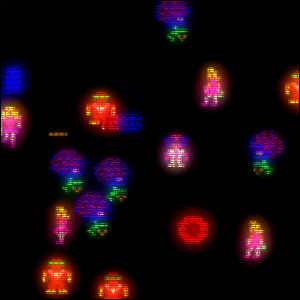 The legendarily tough arcade game Robotron: 2084, designed by Eugene Jarvis (creator of Defender), hits arcades across America and becomes an instant hit. With its two joysticks – one for moving the player’s character, one for firing in any direction – Robotron continues Williams’ hallmark of challenging control schemes, and screws with the fight-or-flight responses of arcade gamers everywhere for years to come.
The legendarily tough arcade game Robotron: 2084, designed by Eugene Jarvis (creator of Defender), hits arcades across America and becomes an instant hit. With its two joysticks – one for moving the player’s character, one for firing in any direction – Robotron continues Williams’ hallmark of challenging control schemes, and screws with the fight-or-flight responses of arcade gamers everywhere for years to come. ![]()
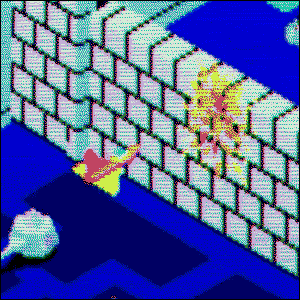 Sega introduces the cult classic arcade game Zaxxon, significantly raising the bar for arcade graphics with its three-quarter isometric 3-D view (and making it nearly impossible to translate faithfully to home video game consoles of the era). Though this new perspective doesn’t make Zaxxon easy to play, it becomes one of the first video games that players line up just to look at.
Sega introduces the cult classic arcade game Zaxxon, significantly raising the bar for arcade graphics with its three-quarter isometric 3-D view (and making it nearly impossible to translate faithfully to home video game consoles of the era). Though this new perspective doesn’t make Zaxxon easy to play, it becomes one of the first video games that players line up just to look at. ![]()
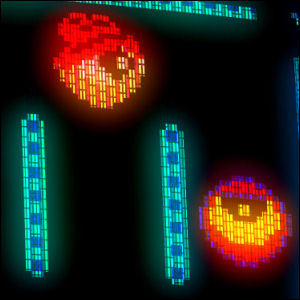 Better known for making jukeboxes and speakers, Rock-Ola makes one of its final attempts to break into the video game industry by releasing Eyes, a maze chase game created by Florida-based Digitrex Techstar. Since many arcades are already flooded with maze games, Eyes seems to disappear from most arcades in a blink; this is one of Rock-Ola’s final attempts to get into the game business.
Better known for making jukeboxes and speakers, Rock-Ola makes one of its final attempts to break into the video game industry by releasing Eyes, a maze chase game created by Florida-based Digitrex Techstar. Since many arcades are already flooded with maze games, Eyes seems to disappear from most arcades in a blink; this is one of Rock-Ola’s final attempts to get into the game business. ![]()
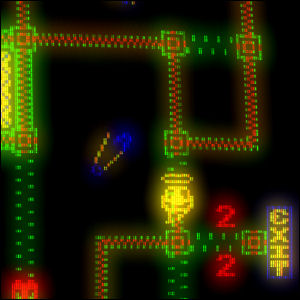 Exidy’s utterly bizarre coin-op video game Pepper II arrives in arcades, and players are given the task of guiding an angelic being on his mission to zip up a maze made of zippers while pursued by little devils. While trying to figure out if any of it makes sense, the industry spends far too much time coining phrases like “wouldn’t you like to be a Pepper II?”
Exidy’s utterly bizarre coin-op video game Pepper II arrives in arcades, and players are given the task of guiding an angelic being on his mission to zip up a maze made of zippers while pursued by little devils. While trying to figure out if any of it makes sense, the industry spends far too much time coining phrases like “wouldn’t you like to be a Pepper II?” ![]()
 Williams Electronics unleashes an arcade favorite in the making, Moon Patrol. A rare case of a foreign game (originated in Japan by IREM) licensed for American distribution by Williams, Moon Patrol forces prospective moon buggy drivers to make split-second decisions about whether to shoot oncoming obstacles or vault over them in the moon’s low gravity. The game’s colorful graphics and inordinately jaunty music make it an instant hit.
Williams Electronics unleashes an arcade favorite in the making, Moon Patrol. A rare case of a foreign game (originated in Japan by IREM) licensed for American distribution by Williams, Moon Patrol forces prospective moon buggy drivers to make split-second decisions about whether to shoot oncoming obstacles or vault over them in the moon’s low gravity. The game’s colorful graphics and inordinately jaunty music make it an instant hit. ![]()
 Konami introduces the arcade game Tutankham in the United States through licensee Stern. A running firefight through a maze, Tutankham tasks players on a deadly treasure hunting mission with a rarity for an arcade game – a definite end goal.
Konami introduces the arcade game Tutankham in the United States through licensee Stern. A running firefight through a maze, Tutankham tasks players on a deadly treasure hunting mission with a rarity for an arcade game – a definite end goal. ![]()
 Atari releases the arcade video game Kangaroo, developed by Sun Electronics. The game proves popular enough in arcade to merit home console ports, at least on Atari’s own consoles.
Atari releases the arcade video game Kangaroo, developed by Sun Electronics. The game proves popular enough in arcade to merit home console ports, at least on Atari’s own consoles. ![]()
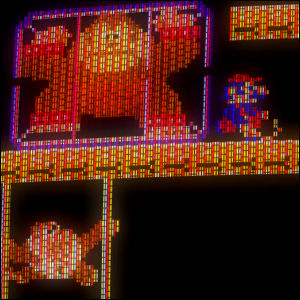 Nintendo follows up on the hugely successful Donkey Kong arcade game with its first sequel, Donkey Kong Junior. Not only does the new game prove that the original’s success wasn’t a fluke, but it gives Mario his name for the first time (well, his first name) and throws in some role reversal, putting the player in the position of having to save Donkey Kong, who was the first game’s nemesis.
Nintendo follows up on the hugely successful Donkey Kong arcade game with its first sequel, Donkey Kong Junior. Not only does the new game prove that the original’s success wasn’t a fluke, but it gives Mario his name for the first time (well, his first name) and throws in some role reversal, putting the player in the position of having to save Donkey Kong, who was the first game’s nemesis. ![]()
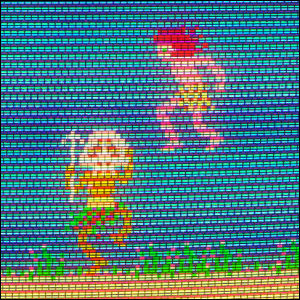 Japanese arcade game manufacturer Taito introduces its latest game, Jungle King, though the game will be known by that name for all of three months. A sampled “Tarzan yell” draws the legal wrath of the Edgar Rice Burroughs estate, and Taito rushes to replace the loincloth-clad player character with a more covered-up, pith-helmeted explorer, retitling the game Jungle Hunt in the process.
Japanese arcade game manufacturer Taito introduces its latest game, Jungle King, though the game will be known by that name for all of three months. A sampled “Tarzan yell” draws the legal wrath of the Edgar Rice Burroughs estate, and Taito rushes to replace the loincloth-clad player character with a more covered-up, pith-helmeted explorer, retitling the game Jungle Hunt in the process. ![]()
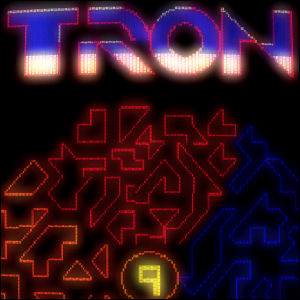 Bally/Midway releases the official Tron arcade game, based on Disney’s movie, in the United States. Containing multiple games based, either directly or loosely, on action setpieces from the movie, the arcade game is an instant hit even as the film struggles in theaters.
Bally/Midway releases the official Tron arcade game, based on Disney’s movie, in the United States. Containing multiple games based, either directly or loosely, on action setpieces from the movie, the arcade game is an instant hit even as the film struggles in theaters. ![]()
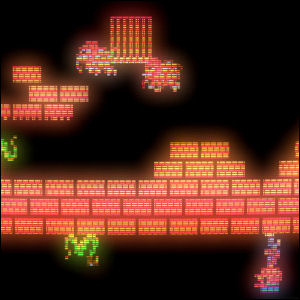 Taito releases the arcade video game Zoo Keeper.
Taito releases the arcade video game Zoo Keeper. ![]()
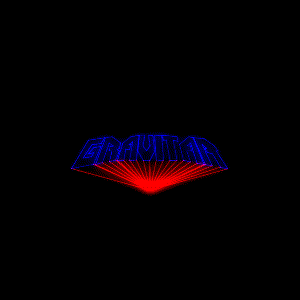 Atari releases the arcade video game Gravitar.
Atari releases the arcade video game Gravitar. ![]()
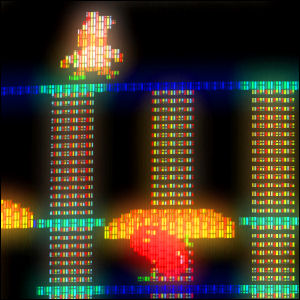 Data East’s food-obsessed arcade game Burgertime debuts in the United States, licensed locally by Midway. Challenging players – who may or may not be old salts at the fast-food business – to work their buns off trying to complete several burgers despite a revolt by the ingredients, Burgertime becomes a hit with seasoned gamers.
Data East’s food-obsessed arcade game Burgertime debuts in the United States, licensed locally by Midway. Challenging players – who may or may not be old salts at the fast-food business – to work their buns off trying to complete several burgers despite a revolt by the ingredients, Burgertime becomes a hit with seasoned gamers. ![]()
 With the words “Prepare to joust, buzzard bait!”, Williams Electronics launches an arcade sleeper hit built on unlikely juxtapositions (medieval knights, jousting with lances, riding on ostriches, over a lake of lava, stalked by pterodactyls). Joust becomes immensely popular for its simultaneous two-player mode, in which one’s buddy can be as much of a liability as any of the computer-controlled enemies. Whispers of movie deals based on the game are briefly heard before the video game industry’s fortunes change at the end of the year.
With the words “Prepare to joust, buzzard bait!”, Williams Electronics launches an arcade sleeper hit built on unlikely juxtapositions (medieval knights, jousting with lances, riding on ostriches, over a lake of lava, stalked by pterodactyls). Joust becomes immensely popular for its simultaneous two-player mode, in which one’s buddy can be as much of a liability as any of the computer-controlled enemies. Whispers of movie deals based on the game are briefly heard before the video game industry’s fortunes change at the end of the year. ![]()
 Taito America releases the arcade game Change Lanes, designed by Dave Needle, in American arcades. The game is an early mash-up of first-person racing and combat genres, putting players in the driver’s seat of a multi-terrain car that must ram through enemies and avoid missiles launched by aircraft to survive long enough to refuel.
Taito America releases the arcade game Change Lanes, designed by Dave Needle, in American arcades. The game is an early mash-up of first-person racing and combat genres, putting players in the driver’s seat of a multi-terrain car that must ram through enemies and avoid missiles launched by aircraft to survive long enough to refuel. ![]()
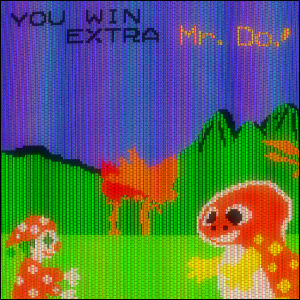 Universal (a video game manufacturer unrelated to the Hollywood studio of the same name) introduces a cute arcade action game, Mr. Do!, casting players as a clown with a deadly weapon to use against underground monsters. Mr. Do! leads a revolution in the video game industry not with its game play, but with its form factor: it is sold as a conversion kit which can be plugged into a generic arcade cabinet, a concept which could potentially save arcade operators thousands of dollars by sparing them the expense of having to purchase an entire new machine to swap out games.
Universal (a video game manufacturer unrelated to the Hollywood studio of the same name) introduces a cute arcade action game, Mr. Do!, casting players as a clown with a deadly weapon to use against underground monsters. Mr. Do! leads a revolution in the video game industry not with its game play, but with its form factor: it is sold as a conversion kit which can be plugged into a generic arcade cabinet, a concept which could potentially save arcade operators thousands of dollars by sparing them the expense of having to purchase an entire new machine to swap out games. ![]()
 Sega releases the arcade game Tac/Scan in American arcades. The vector graphics coin-op switches rapidly between a traditional overhead view and a first-person view several times during each game, including a sequence in which players are asked to navigate a dizzying warp tunnel.
Sega releases the arcade game Tac/Scan in American arcades. The vector graphics coin-op switches rapidly between a traditional overhead view and a first-person view several times during each game, including a sequence in which players are asked to navigate a dizzying warp tunnel. ![]()